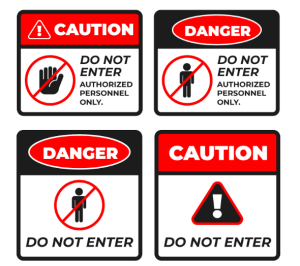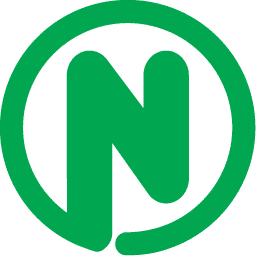What are safety signs, and why do they matter?
Safety signage is a visual display that communicates information about hazards, risks, or safety instructions in workplaces, establishments, or public spaces. They can be found in various forms, such as signs, labels, stickers, posters, banners, or decals. They can also use different elements, such as words, phrases, sentences, images, pictograms, shapes, colors, or symbols.Safety signage is important for businesses because it can help them achieve various goals, such as:
- Prevent accidents, injuries, or illnesses: Safety signage can warn workers and visitors of the potential dangers or risks in a specific area or activity. They can also provide guidance on how to avoid or minimize those dangers or risks. For example, a warning sign can alert workers to high-voltage equipment and instruct them to wear protective gloves and shoes.
- Comply with regulations and standards: Safety signage can help businesses meet the legal or ethical requirements for health and safety in their industry or sector. They can also help businesses follow the best practices or recommendations from authorities or organizations. For example, a fire safety sign can inform workers of the fire exit route and the location of the fire extinguisher as per the fire safety regulations.
- Create a safe and healthy work environment: Safety signage can help businesses foster a culture of safety and health among their workers and visitors. They can also help businesses improve their reputation and credibility as a responsible and caring employer or service provider. For example, an emergency sign can encourage workers to report any incidents or injuries and seek medical attention if needed.

| Key Takeaways |
| – Safety signage is a visual display that communicates information about hazards, risks, or safety instructions in workplaces, establishments, or public spaces. |
| – There are 5 types of safety signage based on their function: warning, prohibition, mandatory, emergency, and fire safety. |
| – Each type of safety signage has a different color, shape, and symbol that conveys its meaning and purpose. |
| – Safety signage can help businesses prevent accidents, injuries, or illnesses, comply with regulations and standards, and create a safe and healthy work environment. |
| – Safety signage should follow the principles of helpful, reliable, and people-first content, as Google recommends. |
What are the 5 types of safety signs at the workplace?
There are 5 types of safety signage at the workplace based on their function:
- Warning Signs: These signs are used to indicate a hazard that may cause injury or death if not avoided. They usually have a yellow background with a black triangle and a black pictogram inside. The word “WARNING” may also be written on the sign. Examples of warning signs are electric shock, explosions, or falling objects.
- Prohibition Signs: These signs are used to indicate an action that is forbidden to ensure safety. They usually have a red background with a white circle and a red diagonal line across a black pictogram inside. The word “DO NOT” may also be written on the sign. Examples of prohibition signs are do not smoke, do not enter, or do not touch.
- Mandatory Signs: These signs are used to indicate an action that must be taken to ensure safety. They usually have a blue background with a white circle and a white pictogram inside. The word “MUST” may also be written on the sign. Examples of mandatory signs are wearing a face mask, wearing eye protection, or using earplugs.
- Emergency Signs: These signs are used to indicate the location of emergency equipment or facilities that may be needed in case of an emergency. They usually have a green background with a white rectangle and a white pictogram inside. The word “EMERGENCY” may also be written on the sign. Examples of emergency signs are fire extinguishers, first aid kits, and emergency exits.
- Fire Safety Signs: These signs are used to indicate the location of fire alarms and fire-fighting facilities. They usually have a red background with a white rectangle and a white pictogram inside. The word “FIRE” may also be written on the sign. Examples of fire safety signs are fire alarms, fire hose reels, or fire blankets.
Each type of safety signage has a different color, shape, and symbol that conveys its meaning and purpose. The table below summarizes the characteristics of each type of safety signage:
| Type | Color | Shape | Symbol | Meaning |
| Warning | Yellow | Triangle | Black pictogram | Be careful |
| Prohibition | Red | Circle | The red diagonal line across black pictogram | Do not |
| Mandatory | Blue | Circle | White pictogram | Do this |
| Emergency | Green | Rectangle | White pictogram | Emergency equipment or facility |
| Fire Safety | Red | Rectangle | White pictogram | Fire alarm or fire-fighting facility |
How to Create Effective Safety Signages for Your Business
Creating effective safety signage for your business requires careful planning and execution. Here are some steps to follow:
- Identify the hazards and risks: You should conduct a risk assessment to identify the potential hazards and risks in your workplace or premises. You should also consider the frequency, severity, and probability of those hazards and risks.
- Select the appropriate signage: You should choose the type, color, shape, and symbol of the signage that best suits the hazards and risks you identified. You should also consider the visibility, accessibility, and durability of the signage.
- Design the signage: You should follow the design principles and guidelines for safety signage, such as:
- Use clear and simple language that is easy to read and understand
- Use high-contrast colors that make the text stand out from the background
- Use appropriate fonts that match the tone and style of the message
- Use images that are relevant and appealing to the target audience
- Use white space to create balance and focus on the message
- Use consistent branding elements, such as logo, colors, and fonts, across all signage
- Install the signage: You should install the signage in strategic locations where it can be easily seen and followed by workers and visitors. You should also ensure that the signage is securely fixed and properly maintained.
- Evaluate the signage: You should monitor and measure the effectiveness of your signage by collecting feedback from workers and visitors, conducting audits or inspections, or analyzing data or statistics.
To create effective safety signage for your business, you should also follow the principles of helpful, reliable, and people-first content, as recommended by Google1. This means that your signage should:
- Provide original, relevant, and comprehensive information that is beyond the obvious
- Provide insightful analysis or interesting information that adds value and originality
- Provide a descriptive, helpful summary of the content in the main heading or page title
- Provide clear sourcing, evidence of expertise, and background information about the author or the site that publishes it
- Provide a great page experience that is fast, secure, mobile-friendly, and easy to navigate
- Focus on benefiting people, not gaining search engine rankings
- Avoid copying or rewriting other sources without adding substantial value
- Avoid exaggerating or being shocking in nature
- Avoid creating search engine-first content that is stuffed with keywords or irrelevant links
Related Questions and Answers
Here are some related questions and answers that people might have about safety signage:
| Question | Answer |
| What are the benefits of safety signage? | Safety signage has various benefits for businesses, such as: – They can prevent accidents, injuries, or illnesses by warning workers and visitors of potential hazards or risks; – They can comply with regulations and standards by meeting the legal or ethical requirements for health and safety in their industry or sector; – They can create a safe and healthy work environment by fostering a culture of safety and health among their workers and visitors – They can improve their reputation and credibility by showing their responsibility and care as an employer or service provider |
| What are the challenges of safety signage? | Safety signages may also face some challenges, such as: – They may not be effective if they are not visible, accessible, or durable; – They may not be understood if they are not clear, simple, or consistent; – They may not be followed if they are not relevant, appealing, or persuasive; – They may not be updated if they are not monitored, measured, or evaluated |
| What are the trends in safety signage? | Safety signage may also follow some trends, such as: – Using digital signage that can display dynamic and interactive content; – Using eco-friendly signage that uses renewable materials or energy sources – Using personalized signage that can tailor the content to the individual viewer; – Using social media signage that can integrate with online platforms or networks |
Conclusion
Safety signage is a visual display that communicates information about hazards, risks, or safety instructions in workplaces, establishments, or public spaces. They have five types based on their function: warning, prohibition, mandatory, emergency, and fire safety. Each type has a different color, shape, and symbol that conveys its meaning and purpose. They can help businesses prevent accidents, injuries, or illnesses, comply with regulations and standards, and create a safe and healthy work environment. To create effective safety signage for your business, you should follow some steps and principles that will help you identify the hazards and risks, select the appropriate signage, design the signage, install the signage, and evaluate them.
